The International Fruit Tree Association’s 64th annual conference in February was held virtually, but that didn’t stop IFTA from visiting leading Honeycrisp orchards across North America. Video “bus tours” took attendees to four orchards, where expert growers described how they grow the profitable, but difficult, variety in their regions.
This story covers two of the stops, in Michigan and New York. Read about the Washington and Nova Scotia stops in the April 1 issue of Good Fruit Grower.
Michigan
Chris Kropf of Hart Farm Orchards in Michigan discussed three of his Honeycrisp blocks in the video — two blocks he transitioned from 3D to 2D canopies, and a 2D 2019 planting. He’s moving to narrower canopies in Honeycrisp, to get more sunlight for coloring and in anticipation of a more automated harvest.
“We’re farming sunlight,” Kropf said. “The more sunlight, the better the fruit quality.”
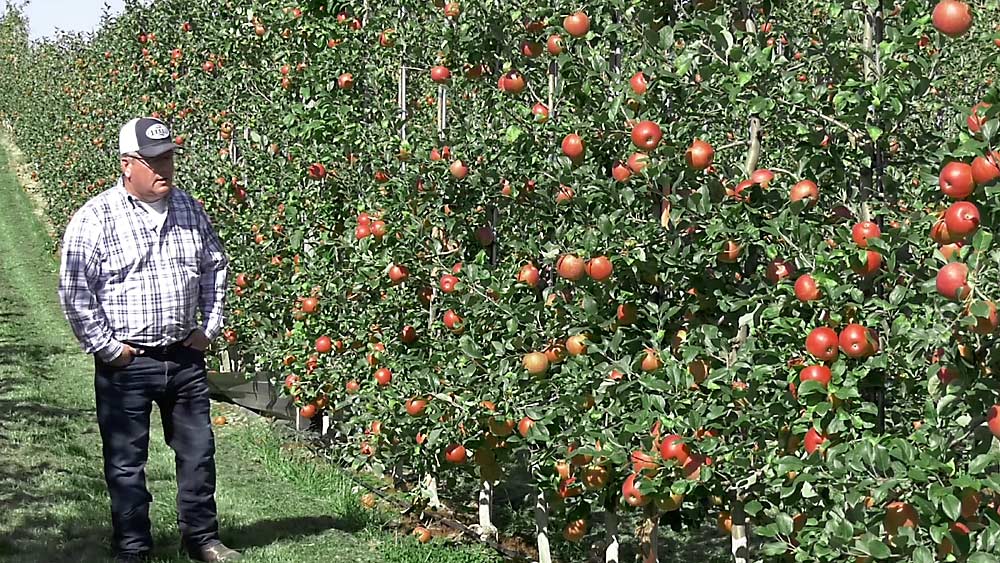
He started in a standard Honeycrisp block, planted at 3 feet by 12 feet in 2007 on Budagovsky 9 rootstock. Originally designed as a 3D system, it’s been retrained to a 2D fruiting wall. He might lose yield that way, but the apples color better — and coloring is everything these days.
“Redder is always better,” he said. “Standard Honeycrisp struggles to get color.”
To increase coloring, he recently began using reflective fabric in the block.
The block’s target yield is 70 to 80 apples per tree, roughly 1,000 bushels per acre, or about 50 bins.
“If we get greedy with yield, we’ve had some trees where they overcropped and just don’t want to color,” Kropf said. “That’s not a good thing in Michigan.”
His crews used a hedger to box in the trees, but now that the trees are settled in their new shape, they might start pruning them back, he said. With B.9, it’s important to keep the crop off in the first couple of years and get the leader to the goal height as quickly as possible.
“If you’re going to grow Bud.9, you’ve got to grow that tree hard and fill space as fast as you can,” Kropf said. “If you don’t fill space, it’ll haunt you for the rest of the life of the orchard.”
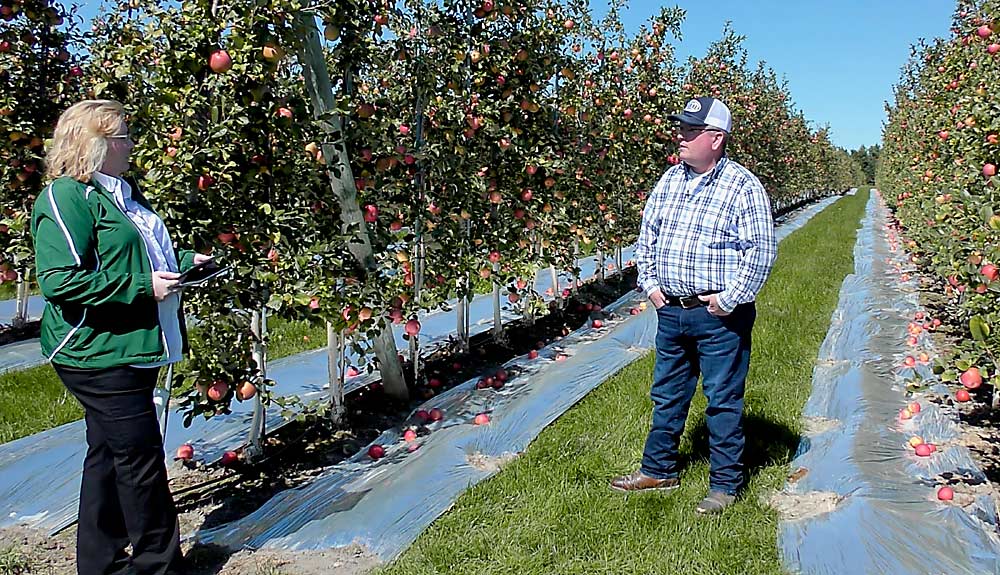
He ground-applies a few shots of calcium nitrate in the second and third years, plus phosphorus and potassium. He also applies plenty of water.
For chemical thinning, Kropf favors NAA (naphthaleneacetic acid). Honeycrisp reacts pretty consistently to chemical thinners, he said. To manage bitter pit, he hits Honeycrisp hard with foliar calcium sprays.
The next block was Royal Red Honeycrisp planted at 3 feet by 12 feet in 2014 on B.9. This block also was transitioned from 3D to 2D. Smoothing the canopy created a “tremendous amount of space” between rows. Kropf’s yield goal for this block is 1,000 to 1,100 bushels per acre. The yield pushed 1,100 in 2019, and he had to pick it three times before all the apples reddened up.
The final planting was Royal Red Honeycrisp planted at 2 feet by 10 feet in 2019 on B.9, trained from day one to a tall spindle system. With 2,100 trees per acre, the yield goal for this block is 1,000 to 1,200 bushels per acre. Tighter spacings probably suit the higher-coloring strain better than standard Honeycrisp, Kropf said, as Royal Red doesn’t need as much sunlight to color.
Kropf’s crews mounded the trees after planting, hoping soil organic matter would give them more vigor. They gave the trees four shots of calcium nitrate and removed all the blossoms by hand — in part to push the trees and in part to avoid fire blight, he said.
New York
At Lamont Fruit Farm in Western New York, temperatures have been trending warmer. Nearby Lake Ontario and the orchard’s elevation, 300 feet above sea level, provide some protection from weather extremes, but temperatures are now reaching higher than 90 degrees Fahrenheit in August and staying in the 80s into September. That makes fruit coloring more of a challenge, said co-owner Jason Woodworth.
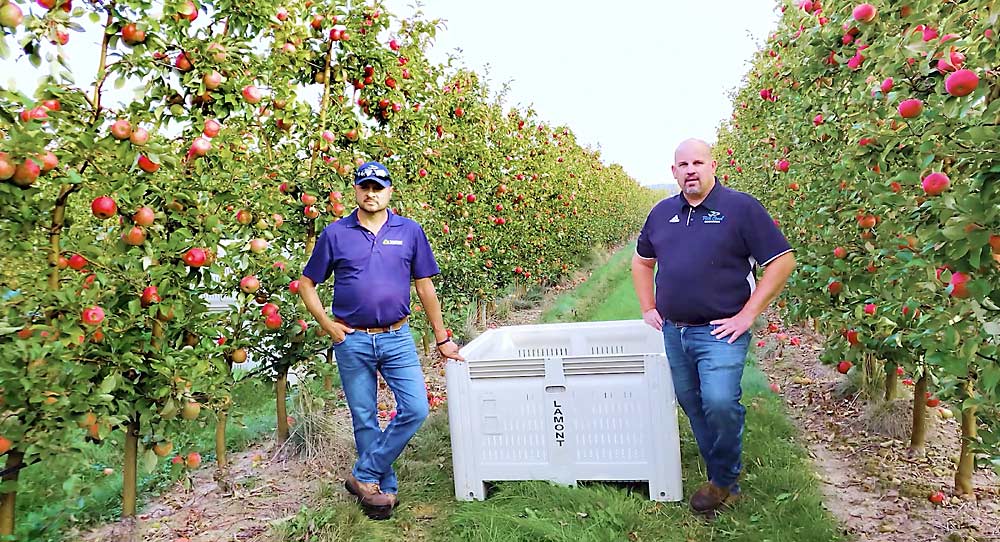
Last September, Woodworth and co-owner Jose Iniguez stood in a standard Honeycrisp block planted at 2 feet by 11 feet on B.9 in 2005. Trained to a tall spindle system, there are about 2,000 trees per acre. The target yield for this block is about 50 bins per acre, which is roughly 1,000 bushels.
Growing their own nursery trees allows them to plant 2,000 trees per acre. It also allows them to plant a 7- or 8-foot tree and expect it to start producing in second leaf. Since 1999, all of the orchard’s Honeycrisp plantings have been on B.9.
To fight bitter pit, they add gypsum in the preplant phase, which has helped them recover some early production. Older blocks on more aggressive rootstocks definitely have bitter pit problems, but they don’t see it as much in the fruiting-wall plantings.
They plant trees in spring, preferably in April, and get trellises, posts and wires up as quickly as possible. They start irrigation immediately and feed the trees aggressively the first two years, until the leaders reach the goal height — now 12 or 13 feet.
The most important thing Woodworth and Iniguez recite to their orchard team is “crop load, crop load, crop load.”
It starts with dormant pruning and mechanical hedging, where the goal is uniformity: They hedge the canopy back to 12 inches on both sides, then pruners take out big wood and create windows of light.
When counting Honeycrisp buds, their rule of thumb is a 2-to-1 ratio of bud to fruit. They want to end up with about 45 apples per tree, so the bud count should be about 90. They halve that bud load with chemical thinners. Their typical thinning program is two applications of ATS (ammonium thiosulfate) at bloom, then four to five thinning passes to “nibble away” with BA (benzyladenine) and NAA or carbaryl.
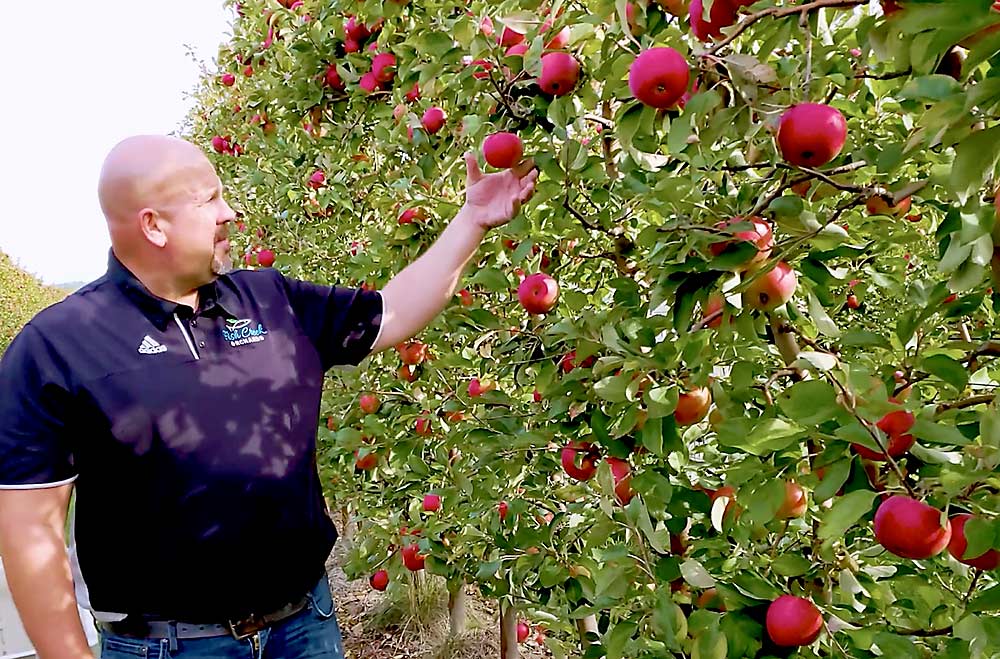
At about the end of June, they hedge the trees back to where they started in March. They’re pretty much done manipulating the trees after that, except maybe for a final hand adjustment.
They no longer use ladders to harvest Honeycrisp. If they could single-pick Honeycrisp they might still use them, but the variety requires at least two picks, which makes a platform much more efficient.
If the Honeycrisps are meant for long-term storage, they’ll stem-clip them. But if harvest is running behind, they’ll abandon the stem clippers and pick conventionally. Apple sizes usually end up between 72 and 64. •
—by Matt Milkovich

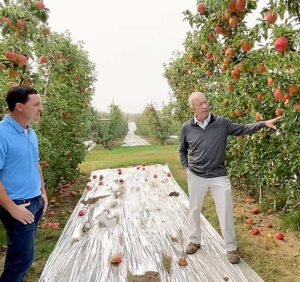
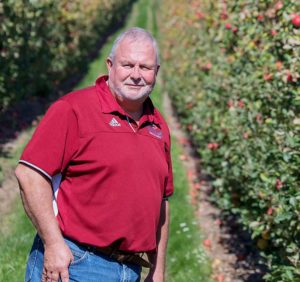





Leave A Comment